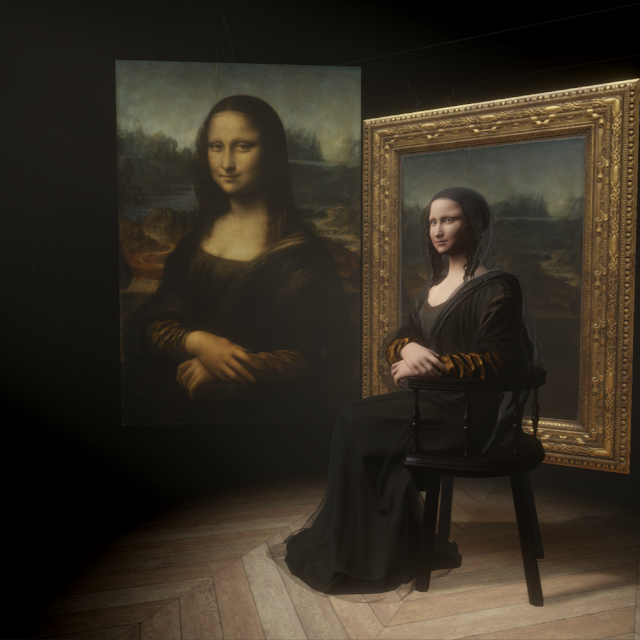Mona Lisa. This is the name of the most famous painting in the world.
The artwork (Konstverket) is painted by the equally world-famous artist Leonardo Da Vinci and is painted on a 77 x 53 cm painting. This is usually what surprises people the most when they see the painting in real life (målningen i verkligheten). That it is actually a rather small painting (liten målning).
Leonardo Da Vinci started the artwork (konstverket) back in 1503 in Florence, Italy and worked on it for at least 3 years. The painting (målningen) was commissioned by Italian businessman Francesco Del Giocondo and would portray his wife Lisa Gherardini. The reason why the artwork today feels like "Mona Lisa" is because Mona is a contraction of Madonna which means "my lady".
Although "Mona Lisa" was a commissioned job, it was never handed over to Del Giocondo. Partly because Leonardo, despite having worked on and off it for at least 3 years, never thought the artwork (konstverket) was finished.
In 1516, Leonardo was invited by King Francis I of France to work on Clos Lucé, near the king's castle. Leonardo took the Mona Lisa with him and may have continued working on the painting (tavla) there. Leonardo worked at Clos Lucé until his death in 1519. The Mona Lisa was still in Leonardo's hands. After his death, Leonardo's assistant, Salai, inherited the Mona Lisa along with many other of Leonardo's works of art (konstverk).
King Francis bought the painting (tavla) for a small fee and kept it in his castle Fontainebleau, where it remained until Louis XIV moved it to the castle of Versailles. Here it hung until the French Revolution in the late 18th century. After that, the painting (målningen) was moved to the world-famous museum The Lourvre, where it still hangs today. However, the painting (målningen) has traveled away from the museum a couple of times.
The most famous of these journeys was when the painting was stolen (målningen blev tillbakastulet) back in August 1911. On the morning of August 21, an artist entered the museum and so that the painting no longer hung on the wall. The artist contacted the guards at The Louvre who believed that the painting (målningen) had been taken down to be photographed for commercial use. A couple of hours later, the reality dawned on the guards and the museum. Mona Lisa was stolen. The Louvre was shut down for a week while commissioners searched for clues on the spot.
The French poet Gulliaume Apollinarie was suspected and arrested, and his friend Pablo Picasso was also interrogated. However, both were acquitted by the police.
It took two years before the painting (målningen) reappeared. One of The Lourvre's employees, Vincenzo Peruggia, had stolen the artwork. He had gone into the museum that day, picked down the painting (målningen) and hidden it in a cupboard. After the museum closed, he had smuggled it out, hidden under his jacket.
Peruggia was an Italian patriot who thought that the Mona Lisa belonged in a museum in Italy (museum i Italien) when it was painted in Florence (målat i Firenze). Later evidence suggests that Peruggia was brought up to steal the Mona Lisa by Eduardo de Valfierne, who after the theft had an artist make six copies of the Mona Lisa to sell them in the United States as the genuine and stolen Mona Lisa.
However, the original remained all the time in Italy in Peruggia's apartment. After two years, Peruggia tried to sell the Mona Lisa to the owners of a gallery in the Uffizi in Florence. Peruggia was taken by the Italian police. The Mona Lisa was then exhibited for two weeks at the Uffizi and was then returned to The Lourve in France. Peruggia received 6 months in prison and was then praised for his patriotism.
The theft of the Mona Lisa is actually the reason why it is so famous today. Before the theft, there were not many outside the art world (konstvärlden) who knew about the artwork (konstverket), but after the theft, it was written about the Mona Lisa in newspapers around the world.
In addition to theft, the painting (målningen) has been subjected to vandalism several times. In 1556, part of the artwork (konstverket) was damaged when a person threw acid on it. That same year, another person threw a stone at the artwork (konstverket). As a result, the Mona Lisa was placed behind a protective glass, which protected the artwork from a woman (konstverket mot en kvinna) who sprayed red paint on it in 1974, and in 2009 where a Russian woman threw a cup of tea against it. The injuries from the first two attacks were repaired with a good result.
In 1962 - 1963, Mona Lisa was on a world tour where the painting (tavla) was exhibited at many different museums. Prior to the tour, the painting (tavla) was valued at approximately $ 100 million (SEK 6.593 billion, adjusted for inflation). However, the tour was a huge success and many millions of people visited the museums where the Mona Lisa was exhibited to see the artwork (konstverket). However, The Louvre has no plans to sell the painting (sälja målningen).

Comments
Post a Comment